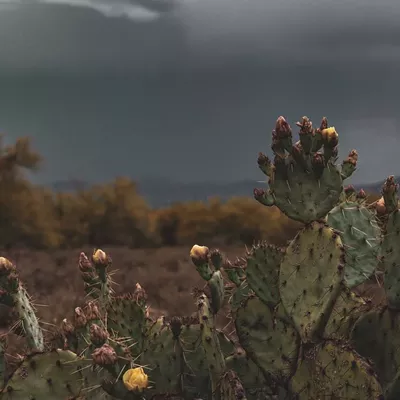The late Frederick Sommer, the legendary Swiss-born photographer who lived in Prescott for nearly 60 years, represents classic black-and-white photography. Shot on film and meticulously printed in the darkroom, each of Sommer's rare gelatin silver prints is remarkably detailed. (Etherton is showing just nine photos.) Every tiny saguaro on a distant hillside ("Arizona Landscape," 1943), every grain of wood in a found piece of lumber ("Flower and Frog," 1947), every strand of fur in a dead animal ("Jackrabbit," 1939), is pristinely rendered.
There are no horizons or empty spaces anywhere: Sommer condensed whole universes into exquisite 8-by-10-inch picture planes. Sometimes he turned his camera on Arizona itself, making distinctive earth-bound landscapes shorn of the standard Western Big Sky. But often, he created his own object-scapes, near-surrealist assemblages of strange things. "Ondine," 1950, pictures a doll's arm set against a piece of abandoned wood; fair enough, but out of the socket of the arm emerges a tiny leg belonging to a tinier doll.
"Objects," 1947, is a collection of chopped-off two-by-fours and tiny metal implements, the kind of things you might find lying around on a barn floor. But Sommer arranged them on a slab of textured concrete, creating a luminous composition that slips with easy grace from light to shadow. The humble wood and metal implements take on a palpable dignity, standing in for the full--and lost--life of the person who once owned them.
Sommer's opposite number is Michael Berman, who's experimenting at the far edges of new photographic technology. A native New Yorker who trained at Arizona State University and now lives in New Mexico, Berman scans his negatives and prints them in carbon pigment, a medium so dense it takes hours for a single image to emerge from the printer. But it's well worth the wait. The carbon yields an impressive painterly range of grays, from pearl to charcoal.
Berman's subject is the violated wilderness. In "Half Missile, BMGR," 2005, a broken military rocket desecrates the desert, which is bathed in the long, melancholy shadows of late afternoon. Dried-up palms and an abandoned pool covered with nasty graffiti evoke a paradise lost in "Pool & Palms, Gila Bend," 2005. A jagged fragment of a car rusts in the sands in the desolate "American, Los Vidrios," 2005, a modern-day update, automotive-style, of Shelley's crumbling Ozymandias.
While Sommer perfected the small scale allowed by his 8-by-10 viewfinder camera, Berman goes for the gigantic; his sprawling pictures of the Western wilderness stretch almost 4 feet across. But like Sommer's small work, Berman's big work is remarkably detailed. His carbon yields up every one of the feathery twigs of a dead tree ("Tree, Davis Plain," 2004) and the chiseled texture of rocks stretching by the thousands toward distant mountains ("Rubble," 2005).
And both artists make photographs whose lines delicately etch the landscape, like exquisite drawings. Berman's poignant "Crossings, BMGR," 2004, records the hundreds of footprints drawn into the desert sands by migrants struggling toward a new life. And Sommer's pictures of dead coyotes and jackrabbits merging into the earth do much the same thing. Traced out with strong lines, these decaying carcasses are death drawings of a terrible beauty.
Mark Klett, a professor of photography at ASU, prizes both old and new. For years, Klett has gone into the Western deserts and mountains, in search of the landscapes captured on glass negatives by the 19th-century expedition photographers. Klett tracks down these remote haunts and re-photographs them himself. First in his "Rephotographic Survey" and more recently for his "Third View" project, Klett has documented the ways the land changes, and the ways it stays the same.
This time around, he pairs the old images with his new ones in single, gigantic prints. Using virtuoso technique--and occasionally working with fellow photog Byron Wolfe--he scans the classic landscapes of such pioneers as Timothy O'Sullivan and Eadweard Muybridge into his computer, then drops their sepia mountains and boulders among his own overlapping shots. He prints the whole thing out as a single new work, as long and as horizontal as the land itself, with imagery spanning three centuries, from the 19th to the 21st.
One dizzying work, "Four views from four times and one shoreline, Lake Tenaya," 2002, is the handiwork of five different photogs. A Muybridge photo is inset at left, an Edward Weston at right, and a smaller Ansel Adams is dropped into the Weston. These historic works hook onto a brightly colored Klett-Wolfe picture, the old and the new together registering same stunning high-country trees, boulders and a lake.
Sometimes Klett records the passage of time in double fashion. "Panorama of Panum Crater and Mono Lake over three days and one hundred thirty-six years" partners one O'Sullivan from 1868 with six Kletts from 2004. But Klett's pictures are from different times of day, starting with a rosy sunrise at the left and ending with dusk at the right.
"Above Lake Tenaya, connecting views from Edward Weston to Eadweard Muybridge," 2002, is a heroic Yosemite picture that rolls out boulders and pine trees and mountain tops across eight feet of photographic paper. The eight Klett and Wolfe images, shot in a clear black and white, are bookended by Weston's 1936 "Juniper" at left, and Muybridge's 1872 sepia-toned "Ancient Glacier Channel, at Lake Tenaya, Mammoth Plate No. 47." The lines of the rocks and peaks continue almost flawlessly from one image to the next, from one century to another.
In this case, Klett documents with some satisfaction that the land has been preserved more or less intact. But he also adds new information to the historic photo. For the first time, we see how Muybridge tilted his camera to get the composition he wanted--Klett has inserted it at a slant to make it match up--and for the first time, we get the whole panorama that Weston and Muybridge edited down in their viewfinders.
Klett's new work is a sophisticated commentary on art and artifice. He makes us understand how much of photography is about selecting, about gazing at the infinity of images in the world and choosing. And, perhaps for the first time, we finally understand that, most of all, photography is about seeing.













